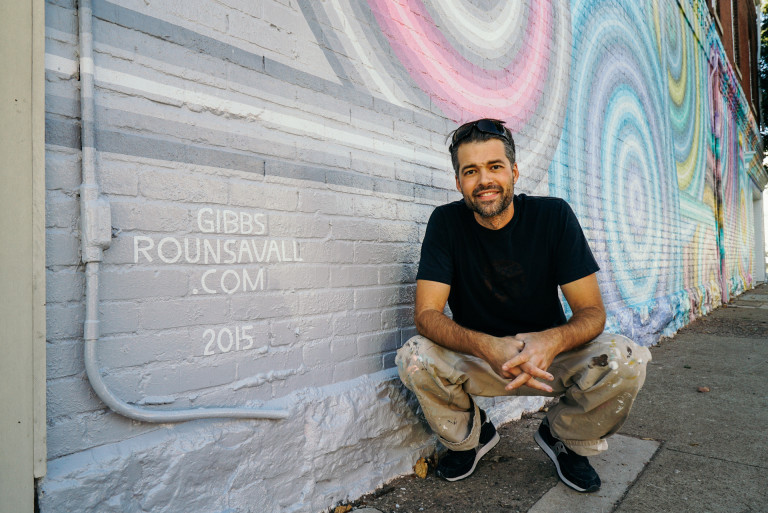At the corner of Shelby and Oak, there’s a sudden burst of color. Circles of yellow, violet, and turquoise nest and flow into each other, lending the corner a sense of movement and energy that’s calming instead of hectic.
Those colorful circles make up a mural called Sunshine and Shadow, the latest project from artist Gibbs Rounsavall ’94. It’s one of three new murals commissioned as part of a larger effort to revitalize Louisville’s Shelby Park neighborhood. A week before he started work, Gibbs recalled, “a kid got gunned down a couple blocks from where I was working. That kind of thing hovers over people’s heads. I hope the work can give people a sense of renewal or help lift them up.”
The mural took Gibbs about three months to complete. At 17 feet tall and 60 feet long, it’s easily the biggest project he’s ever tackled, and size wasn’t the only challenge. Working over the course of a Louisville summer, Gibbs found a lot of that summer heat bouncing back from the primed white wall he was working on. “All that reflected heat was intense enough that I lost 10 pounds in water weight while working on it,” Gibbs recalled. “When you work in heat like that, it decreases your appetite, so I was just pounding water and never hungry.”
The mural was commissioned by Access Ventures, a Shelby Park investment group that also purchased and remodeled the building at 741 Oak that now features Sunshine and Shadow. The building is also home to Scarlet’s Bakery, a business serving premium desserts that employs women looking to leave the adult entertainment industry.
Gibbs said that his design for the mural reflects the renewal taking place in the neighborhood. “I knew I wanted something that spoke to the idea of movement. There’s a lot of progress being made in the neighborhood, and I wanted to reflect that. I was already working in this circular format at the time, and the circle lends itself to a sense of unity and wholeness.”
Over the course of the summer, Gibbs said that he had many opportunities to get to know the residents and talk to them about his work. “I got to know a ton of the locals in the area,” he said. “They would stop and compliment me on the job and share stories about the neighborhood. They were really receptive to all the progress that was taking place and were behind everything that was being done to improve the neighborhood.”
Working outside on a project for an extended period left Gibbs with a lot of time to think about how art can become part of people’s daily lives. “When people cross the threshold of a gallery or museum,” he explained, “I feel like there’s a lot of intimidation. People worry that they’re going to make the wrong response or that they shouldn’t ask certain questions, but when it’s out in the public sphere, it’s for everybody who can see it. I think that’s the direction that art should be going—to get out of museums and be out in public for everyone, because it is for everyone and it can benefit everyone.”
One day, Gibbs recalled, “They were doing construction behind me—literally jackhammering the sidewalk four feet from where I was painting—and one of the workers stopped me and said, ‘I’m really into quilts, and this kind of reminds me of quilts.’ I told him that I have a library of books on quilts because I love the patterns and the colors. They’ve informed my work for years. It was really cool that somebody who didn’t have any formal art background picked up on that right away. He might not have said that had the setting been different. Since we were both out on the street, he was comfortable enough to make that comparison and he was right on.”
With the mural finished and a number of shows behind him, Gibbs said that he’s looking forward to having more time to spend in the studio creating new work. His pieces are immediately recognizable: vibrant colors and geometric designs combine in pieces that suggest both balance and movement. Pattern and color remain fascinating to him, Gibbs said. “What has always attracted me to [those ideas] is finding order and balance and achieving a sense of harmony visually. I sometimes think of myself as a failed musician who started painting, and I think that’s why it’s so pattern-focused. There’s rhythm and movement like there is in music, and sometimes with a series I think of the compositions as individual songs on an album.”
As a teacher and chair of the art department at Fairdale High School, Gibbs is continually inspired by the creative energy of his own students. “Most teachers will tell you that the energy that young people bring is infectious,” he said. “I see them experimenting and trying new things, and I bring that from the classroom and store it and channel it into my own work. It kind of becomes symbiotic. My teaching and my work feed each other now. I started teaching so that I could have more time to create work, but now it’s necessary for my work.”
Photos courtesy of Access Ventures


